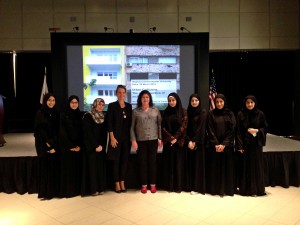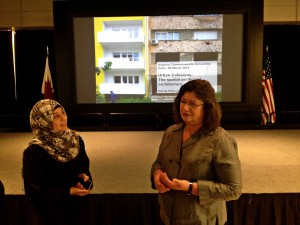Lecture by Wendy Pullan at Virginia Commonwealth University on Conflict Cities reflection.
__________________________________________________________________
“There is no divided city that flourished!”
-Dr. Wendy Pullan
In Dr. Wendy’s point of view, boundaries and city walls:
- Turn a space into an object
- Form disciplinary spaces
- Cause strong psychological divisions
- Cause strong political divisions
- Blanks out the other side of the wall
- Demonize people on the other side… etc.
Infrastructure is a mean of causing city conflict and a way of separating a city… “Roads can act as a fantastic city dividers, specially wide ones.” Two examples of a road dividing a city into two are: the one in Lebanon and Bypass road in Jerusalem.
“What is a bypass road? “Beginning in the 1970s with the birth and emboldening of the settlement movement, Israel has gradually created a new transportation grid in the West Bank. The purpose of much of the new road system is to “bypass” Palestinian towns and villages, connecting Israeli settlements to each other and to the Israeli transportation grid inside the Green Line. Many of these roads are thus referred to as “bypass roads.””
http://peacenow.org.il/eng/content/bypass-roads-west-bank
An example of a city wall in the middle of a city is the city wall in Nicosia, which interrupts Urban Order. The reason behind this is because of the importance of the spaces that are usually located in the middle of the city which are the public spaces, either they be religious spaces, markets, cafe’s or just open spaces. Commonly, these spaces are centres of violence which is why they’re usually destroyed.
As Architects… our role is to think how Architecture can play a positive role in Urban conflict situations.
Dr. Wendy stated that usually Architects do not consider political situations as their job, when it necessarily should be, because Architecture design solves problems!
Hanan Ahmed AlObaidly
____________________________________________________________________
Due to political, religious, economical and cultural differences found in societies, that can lead to conflicts if not controlled resulting in the division of the cities.
Constructing walls and roads that act as the state borders running inside the city, becoming boundaries, separating people and making the city like an object. Restricting the expansion of the city as the periphery is located at the centre of contested cities (Frontier Urbanism)
“Cities are often located at fault lines of culture” which are the shared public spaces (squares, markets, streets) which should bring people together.
Architecture plays a role in urban conflicts, and architects should be aware of conflicts and try to solve them by design.
Amal Saleh Al-Kubaisi
____________________________________________________________________________
Cites are the fault lines of cultures, where mingling happen and people connect, this is the essence of a city; diversity.
When cities become targets in wars by city haters, they get demolished and inner conflicts arise.
That is how cities get divided and boundaries are created.
The boundaries can be beautiful they can unify a city just like olden cities where the boundaries protect it just like the city of Nicosia.
The new boundaries of conflict cites create a sociological effect where the people think better of themselves that the people on the other side, which is the case in Jerusalem in Palestine.
These boundaries should not be forgotten since they create a very big part of the cities’ history.
Aisha Ali Alkhelaifi
________________________________________________________________________
Due to diversity in cultures, religion and economic level that happens in cities, leads to the separation of cities and conflicts.
As Dr. Wendy’s she was mentioning that divided cites common increasing. and this division happens by walls infrastructure roads . in historical cities if we recall some like Baghdad round city and Nicosia they had the walls that identify the city limit or border and it was mainly for security and protection.
Cities locate where population is where we can see the diversity of culture where they shared public spaces markets and streets which brings people together and here shows the importance of public spaces.
Dr. Wendy’s stated that Architects should think about all the aspects even the political issues where it can create a positive impact on the city it self.since Architecture design is solving problems .
Abida Hakim Khan
________________________________________________________-
As Architecture and Urban Design are affected by the culture and social life of a city, it is also affected by the political conditions of that city. Not to mention the very well-known example of a city in conflict “Jerusalem” Mentioned by (Dr. Wendy Pullan at Virginia Commonwealth University), divided by a “bypass road” connecting all of the Israeli settlements and passing by Palestinian villages and towns. This road in itself is a space that separates the Israeli and Palestinian from each other. Although they may share some public spaces, still houses and settlements, are separated. This separation causes the development of one part of the city while leaving the other side neglected
As Dr. Wendy added in the Lecture, the Architecture’s role in this situation is to orient the divided cities towards a developed urbanism. On the other hand, many architects claim that architecture and the design of space does not have anything to do with politics, this is in fact not true, an architect should know about the political issue and should be able to find a way to design a place that would resolve the issue, or at least develop the space.
Another Example of a city in conflict is “Nicosia” mentioned by Dr. Anna. The main reason the city was divided by a green line buffer zone for 70 years is because of the military conflicts. An award winning project contributed in stitching the torn city again. The city was able to progress a master plan for Architectural Conservation targeting both side of the divider zone in the middle of political conflict.
Dr. Anna also mentioned that this green line -which is more like a space- was converted by good design and landscape to a beautiful memorial place. In which it reflects the rich past of Nicosia.
Reem Zaghmout
ـــــــــــــــــــــــــــــــــــــــــــــــــــــــــــــــــــــــــــــــــــــــــــــــــــــــــــــــــــــــــــــــــــــــــــــــــــــــــــــ
*Conflict in Cities and the Contested State’ focuses on divided cities as key sites in territorial conflicts over state and national identities, cultures and borders.
*Conflict in Cities and the has two main reciprocal aims:
- To further our understandings of the nature and dynamics of conflicts over state identity and territoriality insofar as they are manifested in divided cities; and, conversely:
- To understand how cities and everyday urban life are used (and abused) in the regulation or containment of these wider national conflicts, and to explore their potential uses for achieving the self-sustaining moderation, constructive channelling or resolution of conflict.
*Dr. Wendy’s stated Nicosia- 38 years after the UN buffer zone was established
*Also Dr.Wendy’s mentioned about the shared space:
-Socio-political experience varies and affect perception of space, but space is not only produced, space has impact upon experience and memory- in peace and conflict.
-Importance of public space usually these spaces pre-exit conflicts.
-customary practice- everyday life.
-very difficult to devise new shared spaces.
Rand Faris Abdulateef
ـــــــــــــــــــــــــــــــــــــــــــــــــــــــــــــــــــــــــــــــــــــــــــــــــــــــــــــــــــــــــــــــــــــــــــــــــــــــــــــ
Walls play an important role in the spatial configuration of cities. In addition to being one of the main factors or components in the configuration of spatial structure, a wall can also be assigned various intangible social meanings. Those walls or boundaries of conflict cities generate a sociological effect where the people feel more secure and live in a better way from others, who are outside the walls such as Jerusalem in Palestine.
Cities get divided by creating boundaries in war situations. Hence, internal conflicts begin to emerge. In spite of these conditions, borders can be beneficial such create open public spaces, unifying the city itself and give it the sense of protection, which is the case of city of Nicosia. At the same time, this wall disturbs the Urban Order. Usually, these spaces are centers of vehemence that is why they are commonly demolished.
Dr. Wendy stated that Architects should play a positive role in urban conflict situations and they must consider the political situations as their job, because Architecture design solves problems.
Fatma Ahmed O. Fakhroo
_________________________________________________________________________
As Fatima said walls play a major role in dividing cities. These conflict infrastructures can be complex and manifest themselves in various ways, with knock-on effects for socio-economic connection or division. Social and political divisions may be exacerbated when populations are separated physically for long periods, resulting in a rejection of difference and distaste for mixing. Thus, conflict infrastructures can become more than just physical obstacles to reconciliation.
Israeli settlements in Jerusalem are some of the best known examples. Such settlements are always separate from neighboring Palestinian villages, with little if any direct physical access between them.
Conflict in Cities explores how divided cities have been shaped by ethnic, religious and national conflicts, with particular reference to architecture and the urban as a setting for everyday activities and events. It is concerned with how cities can resist and play a role in transforming such conflict.
Fatima AlNuaimi
________________________________________________________________
Conflicts accurse within cities creating divisions within the same city according to economic, religious and cultural differences.
Conflicts leads to many planning problems where in one city 2 of each facility must be maintained, since walls are created in dividing the city having as if 2 cities within the same boundary. People, activities, services and many other events are separated due to that separation.
City’s activities happening with in main squares, markets or streets are ment to gather people together, where these conflicts are creating the opposite
Architects must try to solve conflicts by design.
Noor Salameh
________________________________________________________________
“I remember when the Berlin Wall fell and suddenly intractable problems get solved.”
-Lucy Walker
Walls, buffer zones, checkpoints, urban enclaves, and even large roads, tramways and motorways, continue to play a major role in dividing cities. These conflict infrastructures can be complex and manifest themselves in various ways, with knock-on effects for socio-economic connection or division.
Some forms of conflict infrastructure, once a frontier is created it is extremely difficult to dismantle it, making previous, or even new, functional urban relationships precarious or non-existent. Berlin, which has instituted by far the most successful attempt to remove the physical traces of division, the continuity of functional urban relationships has not been completely possible. Large former border areas remain uninhabited and problematic in parts of the city. Frontier urbanism presents a new and largely irreversible urban condition.
The exercise of democracy depends upon having a public commons where people can gather as citizens – squares, maidans , or a park. Public spaces also enrich lives by providing sites for festivals, celebrations, expressions of community identity, or simply a space to breath at leisure.
Moza AlMarri


